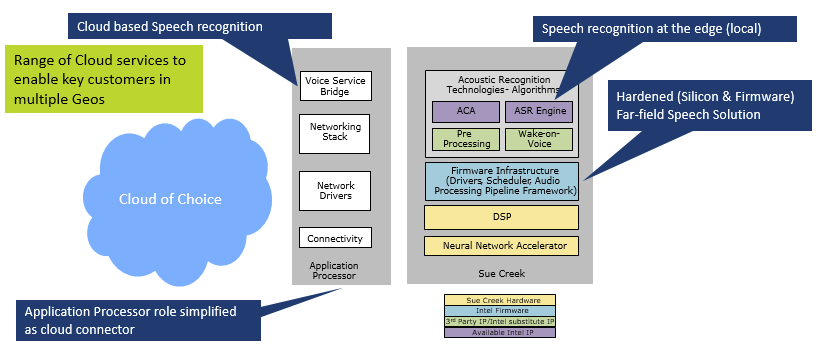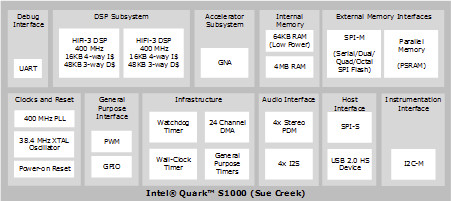Intel may have announced plans to discontinue several of their IoT boards, but based on some documents I received, the company has not given up on the Quark family, although they may have given up on the Intel architecture for low power microprocessor, as Intel Quark S1000 – codenamed “Sue Creek” – will feature two Tensilica LX6 cores (yes, just like ESP32), and is designed to handle speech recognition at the edge (e.g. locally), so some of your voice commands should still work when Internet is down.
Intel Quark S1000 key features and specifications:
- Digital Signal Processors
- Dual Tensilica LX6 cores @ 400 MHz with HiFi3 DSP
- Single precision scalar floating-point instructions
- 16KB 4-way I$; 48KB 4-way D$
- Up to 2400 DMIPS, 3.2 GMACS (16×16), 800 MFLOPS of Compute
- Speech Accelerators
- A GMM (Gaussian Mixture Model) and neural network accelerator
- Low power keyboard and limited vocabulary recognition
- Up to 9.6 GMACS (16×16) of compute
- Internal Memory
- 4MB shared embedded SRAM
- 64KB embedded SRAM for streaming samples in low power mode
- External Memory Interfaces
- Up to 8MB external 16-bit PSRAM
- Up to 128MB external SPI flash
- I/O Interfaces
- Host I/O – SPI for command and control, I2S for streaming audio, IRQ, reset, wake, optional USB 2.0 HS device
- Microphone – I2S/TDM 9.6 MHz max. bit clock
- Digital Microphone – 4 PDM ports 4.8 MHz max. bit clock
- Speaker – I2S/TDM 9.6 MHz max. bit clock
- Instrumentation – I2C master @ 100/400 MHz
- Debug – UART Tx/Rx/RTS?CTS up to 2.4 Mbaud/s
- GPIO – 10 mA sink/source, 8x PWM outputs
- Power Management / Consumption
- Low power idle (memory retention); voice activity detection; play through; full active
- Clock and power gating support
- < 20 mW voice activity detection
- < 250 mW full active
- Package (preliminary) – FCCSP132 7.45 x 8.3mm 0.6/0.7mm pitch staggered/orthogonal
- Temperature Range – Commercial: 0 to 70 °C; industrial: -40 to +85 °C
 The diagram above shows Quark S100 is supposed to be connected to a host processor providing network connectivity, getting commands over SPI, audio over I2S, and the Intel processor can handle some speech recognition likely for a limited subset of words, and use cloud based recognition for more complex requests. The solution could be used in product like Google Home or Amazon Echo look-a-likes, or other voice-controlled appliances.
The diagram above shows Quark S100 is supposed to be connected to a host processor providing network connectivity, getting commands over SPI, audio over I2S, and the Intel processor can handle some speech recognition likely for a limited subset of words, and use cloud based recognition for more complex requests. The solution could be used in product like Google Home or Amazon Echo look-a-likes, or other voice-controlled appliances.
I don’t know when the processor will be available, and I could not find any information online yet.

Jean-Luc started CNX Software in 2010 as a part-time endeavor, before quitting his job as a software engineering manager, and starting to write daily news, and reviews full time later in 2011.
Support CNX Software! Donate via cryptocurrencies, become a Patron on Patreon, or purchase goods on Amazon or Aliexpress






400 MHz is quite a difference compared to stock 160 on esp32. Any explanation of that (different manufacturing process perhaps?)?
If only they had chosen RISC-V instead of Tensilica at least they could have benefited with the all hype going on!
Intel producing a device with a Tensilica core? That really begs the question of why they chose that core. Was this an Intel original design or was this something that came along with a purchase of another company?
If the former, it’s very hard not to see this and the earlier article about the EOL of the other Quark products as a statement about the whole x86 based Quark product line.
Amazon Echo Auto just used this chip in a release today 20Sep2018. https://www.amazon.com/dp/B0753K4CWG/ref=fs_ods_mf
Product page says ‘Mediatek MT7697, Intel Dual DSP with Inference Engine’ — Quark S1000 is the ‘dual DSP’, I guess.